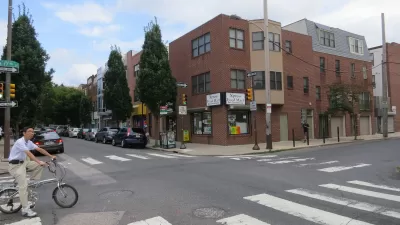Joe Cortright presents the antidote to an emerging narrative about the shifting lifestyle preferences of young adults (i.e., Millennials).

There's been no shortage of recent news reporting data showing young people leaving urban areas—news taken by some as a signal that the end of the back to the city movement of the past decade and more is coming to a close.
However, Joe Cortright has data to counter that narrative, taken from the 2016 American Community Survey. He lists some of the key data:
- "The number of 25-34 year olds with four-year degrees living in large cities is growing almost five times faster than the overall rate of population growth in these cities: a 19 percent increase in 25-34s with a college degree compared to a 4 percent increase in overall population in these cities."
- "The number of well-educated young adults increased in 51 of the 53 principal cities in the nation’s largest metropolitan areas. (Only Rochester, New York and Tucson recorded declines)."
There's more data listed in the article. From this evidence, Cortright draws a few conclusions, including one about planning priorities to address these trends: "Our ability to accomodate [sic] the demands they are making on the scarce and slowly growing supply of great urban spaces and nearby housing is the real challenge we need to focus upon."
The article also includes this table, which the City Observatory has made available to share.
Planetizen has noticed the emerging narrative about the exit of Millennials from urban areas, sharing articles on the subject on many occasions throughout the year. It's might be worth taking another look at these articles with the data Cortright presents in mind.
- A Decade of the Millennial Urban Exodus
- 'Missing Middle' Housing and the Expected Millennial Exodus
- Is This How Millennials Prefer Their Suburbs?
- Richard Florida: 'The Urban Revival Is Over'
- For Discussion: Why Are More Millennials Choosing the Suburbs?
- Survey Finds Surprising Generation Trends in the Real Estate Market
- Census Data: Millennials Choosing the Suburbs; Babies Booming in Big Cities
FULL STORY: Cities continue to attract smart young adults

Maui's Vacation Rental Debate Turns Ugly
Verbal attacks, misinformation campaigns and fistfights plague a high-stakes debate to convert thousands of vacation rentals into long-term housing.

Planetizen Federal Action Tracker
A weekly monitor of how Trump’s orders and actions are impacting planners and planning in America.

San Francisco Suspends Traffic Calming Amidst Record Deaths
Citing “a challenging fiscal landscape,” the city will cease the program on the heels of 42 traffic deaths, including 24 pedestrians.

Defunct Pittsburgh Power Plant to Become Residential Tower
A decommissioned steam heat plant will be redeveloped into almost 100 affordable housing units.

Trump Prompts Restructuring of Transportation Research Board in “Unprecedented Overreach”
The TRB has eliminated more than half of its committees including those focused on climate, equity, and cities.

Amtrak Rolls Out New Orleans to Alabama “Mardi Gras” Train
The new service will operate morning and evening departures between Mobile and New Orleans.
Urban Design for Planners 1: Software Tools
This six-course series explores essential urban design concepts using open source software and equips planners with the tools they need to participate fully in the urban design process.
Planning for Universal Design
Learn the tools for implementing Universal Design in planning regulations.
Heyer Gruel & Associates PA
JM Goldson LLC
Custer County Colorado
City of Camden Redevelopment Agency
City of Astoria
Transportation Research & Education Center (TREC) at Portland State University
Jefferson Parish Government
Camden Redevelopment Agency
City of Claremont





























